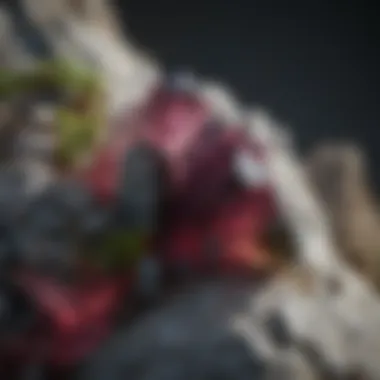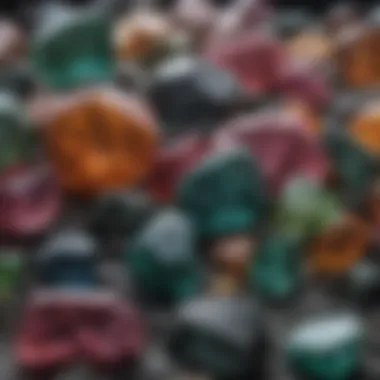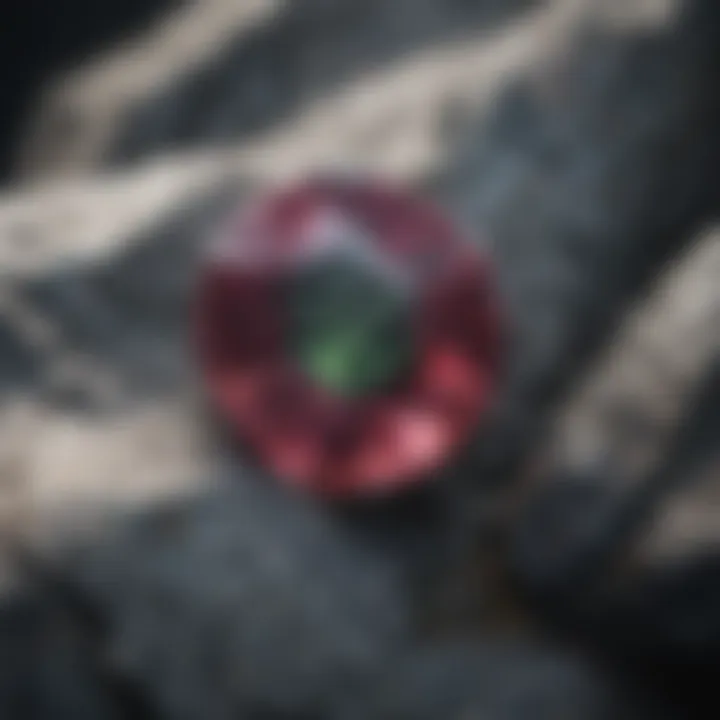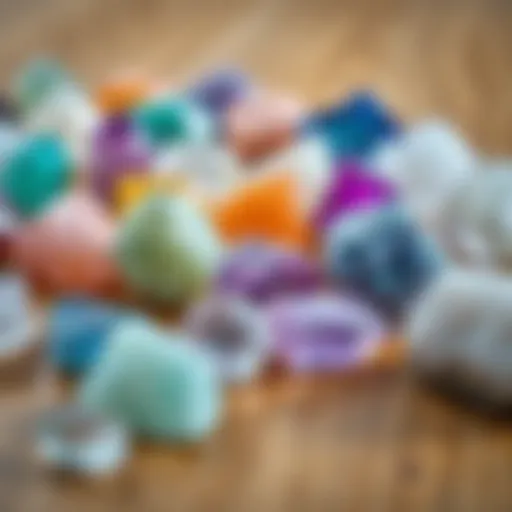Exploring Tourmaline in Granite: Geological Significance


Intro
Tourmaline is a fascinating mineral, particularly in relation to its presence in granite. This article aims to explore the complex interplay between tourmaline and granite, illuminating the geological significance and underlying processes that lead to its formation. By examining the origins, types, and the specific conditions necessary for tourmaline's emergence within granite, we can better appreciate its role not just as a collector's item, but as a critical component within geological frameworks.
Understanding how granite hosts tourmaline involves delving into both its historical context and its mineralogical characteristics, offering a comprehensive perspective on this unique combination.
History and Origins
Tourmaline has a notable history that spans different cultures and geological periods. Its vibrant colors and unique properties have made it a sought-after mineral for centuries.
Overview of Collectibles, Rocks, and Fossils
For collectors, tourmaline in granite exemplifies the charm of geological specimens. It is revered not only for its aesthetic appeal but also for the insights it provides into Earth’s history. Tourmaline can be found in various forms, and its colors range from pink, green to black. Collectors often seek specific varieties that show striking contrast against the granite's typically light-colored matrix. The study of tourmaline embedded in granite can enhance understanding of regional geology.
Historical Significance and Cultural Impact
Tourmaline has been utilized throughout history in jewelry and traditional medicine. In different cultures, different colors were thought to possess unique powers. For example, in some cultures, watermelon tourmaline, which features pink and green hues, has been thought to bring balance and harmony. Understanding the historical context of tourmaline enhances its appeal to collectors, as they seek not just the mineral but also the stories it carries.
Identification and Classification
Understanding how to identify tourmaline within granite is critical for collectors and enthusiasts alike. Various factors come into play, including color, luster, and its crystallographic features.
Guide to Identifying Rocks and Fossils
Tourmaline can often be spotted by the following characteristics:
- Color Variations: Tourmaline displays diverse hues, influenced by its chemical composition. This can range from clear to deep black, and to rich green or pink.
- Crystal Structure: Typically, tourmaline forms in a hexagonal shape, which can help distinguish it from other minerals.
- Luster: The mineral exhibits a vitreous to sub-vitreous luster, enhancing its visual appeal.
- Associated Minerals: Often found with quartz, feldspar, or even in pegmatitic environments, the locality can help determine its identification.
Common Types and Variations
Different types of tourmaline can be classified based on their unique compositions and colors:
- Elbaite: The most common type, known for its vibrant colors and used in jewelry.
- Schorl: Typically black, it is often found in granite.
- Indicolite: A rare blue variant that can occur in igneous rocks.
Intro to Tourmaline
Tourmaline is a fascinating mineral that has garnered significant attention in geology and gemology. Its unique properties and diverse range of colors make it a topic worth exploring, particularly when it exists within granite formations. Understanding tourmaline is essential for both academics and enthusiasts alike, as it relates to broader themes in mineral formation and geological history.
Definition and Composition
Tourmaline is a boron silicate mineral that typically forms in granitic and metamorphic rocks. It exhibits a complex crystalline structure and is composed of varying amounts of elements like aluminum, iron, magnesium, sodium, lithium, and potassium. The general formula for tourmaline is XY3(Z6O18)(BO3)3(V)3, where X and Y are cations that can vary in composition.
This mineral is characterized by its trigonal crystal system, which gives it a unique appearance. Tourmaline can be found in various colors, including pink, green, blue, and even color-changing varieties. The presence of trace elements leads to this diversity of colors, making it not only a subject of scientific interest but also a sought-after gemstone.
Historical Background
The history of tourmaline is as colorful as the mineral itself. Historically, it was often confused with other gemstones like emeralds and rubies due to its vibrant hues. Tourmaline was first described in detail in the early 19th century by scientists studying its unique properties.
The name 'tourmaline' is derived from the Sinhalese word turmali, which translates to 'stone with mixed colors.' This reflects its variety and complexity. For centuries, tourmaline has been utilized in jewelry and decoration.
Notably, the gemstone was popular among collectors and geologists in the 1800s. Its discovery was a milestone, leading to extensive research that advanced mineralogy as a science. Understanding the historical advancements concerning tourmaline enriches our comprehension of its geological significance in modern studies.
Understanding Granite
Granite is a fundamental rock type that has significant implications in geology and mineralogy. It is an igneous rock, primarily composed of quartz, feldspar, and mica. The formation and properties of granite play a crucial role in the understanding of tourmaline's occurrence, as tourmaline is often found embedded within this matrix.
Granite's importance extends beyond its physical presence in the landscape. It serves as a record of the geologic processes that shape our planet. Comprehending granite helps to decipher the intricate relationships between minerals, including tourmaline, and the conditions necessary for their formation.
Formation Process
The formation process of granite involves the slow crystallization of magma beneath the Earth's surface. This method leads to a coarse-grained texture, making it distinct from other igneous rocks that cool quickly on the surface.
Granite generally forms in continental crust, where the conditions allow for the extended cooling of molten rock. This process can take millions of years, resulting in a rock rich in mineral diversity.
- Cooling Rate: The slow cooling allows for larger crystals to develop.
- Location: Granite is often found in mountain ranges, highlighting its significance in tectonic activities.
Understanding these aspects is vital for any collector or enthusiast looking to appreciate the geologic context of tourmaline.
Chemical Composition


The chemical composition of granite is varied yet specific. The primary minerals found in granite include:
- Quartz: Generally clear or white, responsible for the rock's hardness and durability.
- Feldspar: Present in two types – plagioclase and orthoclase, contributing to color variations.
- Mica: Often biotite or muscovite, this mineral adds shine and flakiness to granite.
These minerals are often interspersed with smaller quantities of other minerals, significantly influencing the rock's overall characteristics, including its reaction to environmental factors. The presence of specific minerals can indicate the granite's potential to house tourmaline and thus its geological importance.
Granite not only provides insights into the Earth's past but also helps in understanding the locations where valuable minerals like tourmaline may be found.
Properties of Tourmaline
Tourmaline in granite possesses distinct properties that influence both its geological significance and its appeal to collectors. These properties are essential for understanding how tourmaline forms, interacts with granite, and can be appreciated in various geological contexts. Knowledge of these properties not only enhances a collector's ability to identify genuine specimens but also informs scientific inquiry regarding the conditions of formation within granite environments.
Physical Characteristics
Tourmaline is known for its unique physical characteristics. Its structure often features elongated crystals with a trigonal system. The typical color ranges include yellow, pink, green, and black, with each hue often indicating different trace element compositions.
- Hardness: On the Mohs scale, tourmaline scores between 7 and 7.5, indicating a fairly robust mineral that can withstand typical wear and tear.
- Cleavage: Unlike many minerals, tourmaline displays no perfect cleavage, which means it does not break along defined planes. This attribute results in conchoidal fracture which further contributes to the complexity of its appearance.
- Luster: It generally exhibits a vitreous luster, giving it a shiny quality that enhances its visual appeal.
These physical features make tourmaline a compelling subject for study within granite formations, revealing the environmental conditions under which these minerals develop. By examining the size, shape, and color of tourmaline crystals in granite, geologists can draw connections about the conditions during the mineral's formation.
Optical Properties
The optical properties of tourmaline add another layer of intrigue for both collectors and geologists. Understanding these properties can provide crucial insights into its formation and behavior in granite.
- Pleochroism: Tourmaline displays distinct pleochroism, where it can show different colors when viewed from different angles. This characteristic is particularly beneficial for mineralogists in identifying specific tourmaline varieties.
- Refractive Index: The refractive indices of tourmaline range from 1.61 to 1.69. This variation necessitates careful consideration during identification as it helps in distinguishing tourmaline from similar minerals.
- Transparency: Tourmaline can be transparent to opaque. This feature impacts its desirability among collectors, as transparent crystals tend to have higher aesthetic and economic value.
Tourmaline's optical traits make it a subject of fascination, often guiding collectors in identifying and evaluating specimens.
"The beauty and complexity of tourmaline can contribute significantly to understanding granite's geological narrative."
Occurrence of Tourmaline in Granite
The occurrence of tourmaline in granite is a subject of high geological significance. Understanding where and how tourmaline integrates within granite formations provides insights into not only the mineral itself but also the conditions that prevail during the formation of granite. The presence of tourmaline indicates various geological processes and helps to unravel the history and evolution of the rock. Moreover, this knowledge aids in practical applications, such as mineral exploration and the identification of economically viable resources.
Geographic Distribution
Tourmaline is found in various granite formations scattered across the globe. Key locations include regions in the United States, such as the Black Hills of South Dakota, as well as parts of Brazil and Madagascar. The distribution of tourmaline within granitic terrains often correlates with the specific geological circumstances under which the granite formed.
These locations showcase diverse geological environments that contribute to the formation of granitic rocks. In areas with high metamorphic activity, tourmaline can be quite plentiful. This mineral often forms in pegmatitic varieties of granite, which are characterized by their large crystal sizes. Several factors such as temperature, pressure, and the chemical environment dictate where in the granite the tourmaline will occur.
In addition, significant deposits may be linked to volcanic activity or hydrothermal processes, which further underscores tourmaline's diverse distribution within granite. This mining potential is not only a point of interest for geologists but also attracts collectors, as these areas yield striking specimens.
Forms and Varieties
Within granite, tourmaline manifests in several forms and varieties, each distinguished by unique colors and characteristics. The most recognized varieties include:
- Elbaite: Known for its vivid colors, often showcasing a combination of green, pink, and colorless hues. This variety is highly sought after due to its aesthetic appeal.
- Schorl: Typically black, schorl is one of the most common tourmaline varieties found in granitic rocks, often forming neat, elongated crystals.
- Aquamarine: A blue-green variant, aquamarine is particularly rare in granite settings but is cherished for its beauty.
The crystallization process of tourmaline in granite can result in a range of forms, from large, blocky crystals to fine, needle-like structures. These formations can provide valuable information regarding the conditions of the granite's formation. When studied, the unique internal structures and colors of tourmaline can offer clues about the surrounding environment during its crystallization.
"Understanding the forms and varieties of tourmaline in granite not only enhances mineral identification but also enriches the geological narrative of the region."
Collectors particularly value these diverse varieties within granitic settings, as they can significantly contribute to the economic and aesthetic value of mineral specimens. Additionally, the interaction between tourmaline and other minerals often enriches the aesthetic quality of rock samples, making them appealing to enthusiasts and researchers alike.
The Role of Tourmaline in Metamorphic Processes
Tourmaline plays a significant role during metamorphic processes, especially in the context of granite formations. The presence of tourmaline can significantly affect the overall composition and structure of granite. This section delves into how tourmaline influences granite composition and its interactions with other minerals during metamorphism.
Influence on Granite Composition
The incorporation of tourmaline into granite is not merely a coincidence; it speaks volumes about the mineral's influence on the overall chemistry of the rock. Tourmaline, being boron-rich and a complex silicate, introduces elements that can alter the mineralogical balance within granite.
- Boron Contribution: The presence of boron in tourmaline is critical. This element can modify the melting points of surrounding minerals during metamorphism. The behavior of other minerals like quartz and feldspar can change when boron is involved, potentially creating a unique granite variety.
- Alteration of Mineral Relations: Tourmaline can affect the equilibrium of other minerals. This results in a range of compositions and potentially enhances the diversity of the granite. The coexistence of tourmaline and feldspar, for instance, can yield various textures that reflect geological history.
The outcome of these influences is a granite that may vary in mineral content, creating something distinct compared to typical granite deposits. It exemplifies how tourmaline can be a key player in metamorphic environments, outlining the adaptability of granite in response to changing geological conditions.
Interaction with Other Minerals
The interactions between tourmaline and other minerals are multifaceted. These interactions are crucial during formation and can reveal much about the metamorphic history of a rock formation.


- Compatibility with Feldspar and Quartz: Tourmaline tends to co-occur with both feldspar and quartz. These interactions can assist in stabilizing the overall structure of the granite. For example, they can help prevent the separation of other mineral constituents under high-pressure conditions.
- Metamorphic Pathways: The way tourmaline interacts with other minerals during metamorphism can provide insights into the pathways of rock formation. The presence of tourmaline may indicate specific conditions of temperature and pressure that existed in the environment, thus serving as a natural record of geological history.
These interactions underscore the importance of tourmaline not only as a mineral but also as a vital component in the narrative of rock metamorphism. Understanding how tourmaline interacts with its surroundings gives collectors and geologists a deeper appreciation of granite and its complexities.
"The presence of tourmaline in granite indicates a specific set of geological conditions that may have prevailed during its formation, making it an important indicator mineral in earth sciences."
In summary, the role of tourmaline in metamorphic processes is critical. It influences the chemical composition of granite and interacts meaningfully with other minerals, thereby contributing to our understanding of these geological processes.
Geological Significance of Tourmaline
Tourmaline holds substantial geological significance, especially within granite formations. Its presence offers critical insights into various geological processes and earth conditions during rock formation and alteration. The unique characteristics of tourmaline make it an essential subject for those interested in mineralogy, geology, and even economic geology. Understanding its role in granite allows for a better comprehension of the broader geological environment, aiding both researchers and collectors alike.
Indicator Mineral
Tourmaline serves as a vital indicator mineral in geological studies. This implies it can provide important information about the conditions under which granite formed. Tourmaline crystallizes in response to specific temperature and pressure conditions, and its chemistry can reveal prevailing geological conditions at the time of its formation. For example, distinct varieties of tourmaline often indicate specific alterations in the surrounding mineral composition.
Forms of tourmaline, such as schorl and elbaite, are often found in granitic rocks. They highlight the presence of certain trace elements in the source material. These inclusions can suggest which geological processes were at play, pointing to precipitation events, magma evolution, or interactions with surrounding rocks. Because of these properties, tourmaline becomes a reference point for understanding not just granite but also the entire geological landscape it sits within.
Implications for Mineral Exploration
The implications of tourmaline as an indicator mineral extend into the realm of mineral exploration. Geologists and prospectors can utilize the presence of tourmaline to identify favorable locations for mineral deposits. As tourmaline often occurs with other economically valuable minerals, its identification can guide exploration efforts.
For instance, in regions where lithium-bearing minerals are sought, the presence of tourmaline can suggest a nearby lithium source. Understanding how tourmaline behaves in geological formations enables more informed exploration strategies, leading to increased efficiency in finding new mining opportunities.
In short, analyzing tourmaline not only enhances understanding of granite but also allows for smarter exploration in the search for precious and industrial minerals. Collectors should appreciate these implications, recognizing that the value of tourmaline is not just aesthetic but rooted firmly in its geological story and relevance.
Tourmaline's Role in Economy and Collectibles
Tourmaline holds a distinct position within the realm of geology and economy. Its rarity and varied hues make it an essential component for both commercial ventures and the collectibles market. Understanding the market value and demand for tourmaline, along with guidance for collectors, offers insight into this valuable mineral's broad contributions to both industry and personal passion.
Market Value and Demand
The market dynamics surrounding tourmaline are driven by multiple factors, including hue, clarity, and size. Specific colors like the vivid pink and green tourmalines are particularly sought after, leading to higher prices. The global demand for natural gemstones has increased significantly, and tourmaline is at the forefront.
Some key points to note include:
- Color Variations: The diverse hues of tourmaline contribute to its appeal. Bicolored or multicolored stones tend to attract collectors and can command premium prices.
- Market Trends: As consumer interest in ethereal and unique gems rises, the value of tourmaline continues to climb.
- Luxury Market: High-quality tourmaline is often featured in luxury jewelry, further augmenting its market value.
"The value of tourmaline can shift dramatically based on market trends, regional availability, and mining yield."
Guidance for Collectors
For collectors interested in tourmaline, there are various considerations to bear in mind. Successful collection involves not only acquiring pieces but also understanding the nuances that make each specimen unique. Here are some suggestions:
- Authenticity Check: Ensure the authenticity of the stone through reliable certification. This is critical to maintain the integrity and value of your collection.
- Storage Conditions: It is vital to store tourmaline in stable environments to prevent scratches or damage. Using soft cloths and secure boxes can preserve your collection's condition.
- Networking: Engaging with rock and gem shows allows collectors to connect with others and find unique pieces that may not be available through traditional retail channels.
- Educational Resources: Familiarize yourself with gemology basics, understanding grading systems, and attending workshops to broaden your knowledge of tourmaline.
Pursuing a collection of tourmaline can be rewarding, offering both personal satisfaction and potential financial return. As the market grows, the significance of educating oneself about this mesmerizing mineral can determine successful engagement in both collecting and investment.
Methods of Identification
Identifying tourmaline within granite formations is crucial for various reasons. For collectors and geologists alike, understanding the distinct features of tourmaline can enhance the quality of any collected specimen. This section explores essential techniques that provide insight into tourmaline's characteristics, significance, and proper identification methods.
Visual Examination
Visual examination is the first step in identifying tourmaline. This method involves assessing the mineral for noticeable attributes. Tourmaline exhibits a complex range of colors, often appearing in multiple hues within a single crystal. This pleochroism is a distinguishing feature, as the color may shift when viewed from different angles. Common colors include greens, pinks, and blacks, making visual inspection valuable.
Moreover, the crystal structure of tourmaline is notable. It typically forms a prismatic shape with striations running parallel to the length. Inspecting these physical attributes provides an initial differentiation from other minerals. It’s important to examine transparency and brilliance as well.
For collectors, using a loupe can help to spot inclusions and imperfections, which add character to the crystals. Documenting the visual traits observed aids in comparing findings with textbooks or online databases.
Testing Techniques
While visual inspection provides essential insights, scientific testing techniques offer a more rigorous approach for confirming tourmaline’s identity. Several methods can be employed:
- Hardness Test: Utilizing the Mohs scale allows for the assessment of hardness. Tourmaline ranks between 7 and 7.5, which can help distinguish it from softer minerals.
- Refractive Index Measurement: This technique provides detailed information about tourmaline’s optical properties. Using a refractometer, a specialist can determine the mineral’s refractive index, which varies depending on the tourmaline variety.
- Chemical Tests: Certain acids can be applied to test for specific elements within the mineral. For example, a drop of hydrochloric acid may react with iron-rich tourmaline but not with others.
In addition to these methods, employing a polarizing microscope is useful for studying thin sections of tourmaline. It reveals additional optical properties that facilitate identification. Accurate identification not only enriches the knowledge of tourmaline but also contributes to understanding its role in the geological environment.
Identifying tourmaline with accurate methods enhances not just personal collections but also scientific understanding of the material's geological context.


Mastering visual examination and testing techniques is critical for anyone engaged in collecting or studying tourmaline in granite formations. These methods complement each other and together provide a comprehensive approach to understanding this fascinating mineral.
Preservation and Care of Granite with Tourmaline
The preservation and care of granite that contains tourmaline is crucial for both aesthetic appeal and the long-term integrity of these geological specimens. While granite itself is a durable rock, the presence of tourmaline can introduce specific variables that affect how a collector should approach maintenance. This section discusses the importance of proper care, highlights techniques for cleaning, and offers recommendations for display and storage.
Cleaning Techniques
Cleaning granite specimens embedded with tourmaline requires careful consideration. The goal is to remove dirt and pollutants without damaging the minerals. Here are some effective techniques:
- Gentle Cleaning Solutions: Use a mixture of water and mild soap. Avoid harsh chemicals, as they can degrade the granite and harm tourmaline.
- Soft Brushes: A soft-bristle brush can help remove dirt from crevices without scratching the surface. Brush lightly to avoid damaging the tourmaline.
- Cloths: Use lint-free cloths for drying. This helps to prevent water spots and preserves the mineral's natural shine.
"Proper cleaning not only enhances the appearance but also prolongs the life of the minerals within the granite."
Display and Storage Recommendations
The way tourmaline in granite is displayed and stored plays a significant role in its preservation. To maintain the durability and visual appeal, consider these recommendations:
- Avoid Direct Sunlight: Store or display specimens away from direct sunlight, which can cause fading and deterioration over time.
- Stable Environment: Keep tourmaline specimens in a stable temperature and humidity environment. Rapid changes can lead to cracking in both the granite and the tourmaline crystals.
- Protective Cases: Use display cases with UV protection for showcasing, ensuring that both granite and minerals are shielded from environmental harm.
- Gentle Handling: When moving specimens, handle them gently to prevent any accidental damage to the tourmaline.
Environmental Aspects of Tourmaline Formation
The environmental aspects of tourmaline formation are crucial in understanding the geological context in which this mineral develops within granite. These factors play a significant role in determining the characteristics of the tourmaline, from its color to its internal structure. Analyzing temperature, pressure, and chemical environment reveals how these systems interact to influence the mineral's qualities.
Influence of Temperature and Pressure
Temperature and pressure are fundamental aspects influencing the formation of tourmaline in granite. Typically, tourmaline crystallizes in high-temperature environments, often above 500 degrees Celsius. In the context of granite, these elevated temperatures are typically reached during the slow cooling of magma.
Higher pressures also affect the crystallization process. For instance, in regions where granite is subjected to tectonic forces, increased pressure can lead to a variety of tourmaline forms. At lower pressures, tourmaline may exhibit different mineral compositions, producing distinct color variations. Therefore, the specific temperature and pressure conditions during granite formation are decisive in determining the type and quality of tourmaline that can occur within these rocks.
Impact of Chemical Environment
The chemical environment surrounding the crystallization of tourmaline also greatly affects its formation and properties. Tourmaline is boron-rich, and its formation requires a suitable supply of boron and other elements such as aluminum, iron, lithium, and magnesium. The presence or absence of these components alters the mineralogical properties.
For example, the availability of lithium may lead to the formation of elbaite, a type of tourmaline that often appears in vivid colors. In contrast, the scarcity of certain elements can result in less saturated colors or even less desirable varieties. Additionally, the pH levels of the surrounding environment can influence the stability of particular ions, thus impacting the eventual crystallization of tourmaline.
The interplay between temperature, pressure, and chemical factors creates a unique environment for the development of tourmaline within granitoid rocks, making each specimen a record of its geological history.
Understanding these environmental aspects not only underscores tourmaline's complexity but also provides vital insights for mineral exploration and collection.
Tourmaline and the Rock Cycle
The relationship between tourmaline and the rock cycle is intricate and significant. Tourmaline exists not just as a standalone mineral but also as a crucial component in various geological processes. Understanding its pathways through the rock cycle enhances our comprehension of how this fascinating mineral forms and transforms over geological time.
Pathways through Geological Transformations
Tourmaline is often created under conditions of high pressure and temperature. Its formation typically occurs in igneous and metamorphic rocks. These rocks undergo multiple transformations in the rock cycle, from melting to solidification and metamorphism. Understanding where and how tourmaline forms can provide insights into the conditions present during its creation.
During the granite formation, for instance, there is a crystallization of minerals as magma cools. Tourmaline can crystallize at different stages of this cooling process. As granite weathers, the tourmaline contained within can be exposed and subjected to erosion. These processes contribute to the mineral's journey through the rock cycle, leading to further distribution and deposition in sedimentary environments.
Role in Sedimentary Processes
Once tourmaline is released from granite through weathering processes, it can become a part of sedimentary formations. Sedimentary processes involve the transportation and deposition of weathered materials by water, wind, or ice. Tourmaline possesses a high resistance to weathering, making it durable and more likely to be preserved in these environments.
Some significant points about tourmaline in sedimentary processes include:
- Preservation: Its resilient nature allows tourmaline to maintain integrity despite harsh conditions.
- Transport: It can be carried over long distances from its source, enriching sediment layers with its presence.
- Indicator of Geological History: The presence of tourmaline in sediment can indicate the types of geological processes that have occurred over time.
"The pathways of tourmaline illustrate the continuous transformation of materials within the rock cycle, highlighting its role in the lifespan of various rock types."
Concluding Thoughts
The exploration of tourmaline within granite provides a unique view into both the mineral's characteristics and its geological context. Understanding how this mineral occurs in granite formations adds significant value for both scholars and enthusiasts in the field of geology and mineralogy. It invites a closer inspection of how environmental factors shape not just the mineral's formation but also its physical presence within the rock.
Summary of Findings
Tourmaline is not merely an aesthetic component of granite; its presence can serve as an indicator of specific geological processes. In summary, this article has walked through several key aspects:
- Composition: Tourmaline comprises a complex boron silicate with varying compositions that influence its color and properties.
- Occurrence: It can be found in multiple geological settings, but granite serves as one of the more prominent hosts due to its unique formation conditions.
- Geological Significance: This mineral indicates particular metamorphic pressures and is valuable in mineral exploration, providing insights into the geological history of an area.
Future Research Directions
Looking ahead, there are several potential fields for further research:
- Detailed Characterization: Advanced techniques in mineral characterization can provide more precise details about the different tourmaline varieties found in granite. Understanding these may shed light on their formation environments.
- Geochemical Investigations: Future studies could focus on the geochemical processes that lead to varied tourmaline compositions in granite. It will lead to better markers for exploration in both academic and commercial mining contexts.
- Environmental Impacts: As climate change alters geological processes, studying how tourmaline formation responds to environmental shifts could uncover broader implications for geology.
- Interdisciplinary Studies: Collaborations between mineralogy, geology, and chemistry could yield new insights into tourmaline's role in understanding earth's crust dynamics.
In summation, further examination of tourmaline in granite not only enriches our knowledge of the mineral itself but also contributes to our general understanding of geological processes. The benefits of such inquiries resonate well beyond academic curiosity, intersecting with practical applications in resource exploration and conservation.



